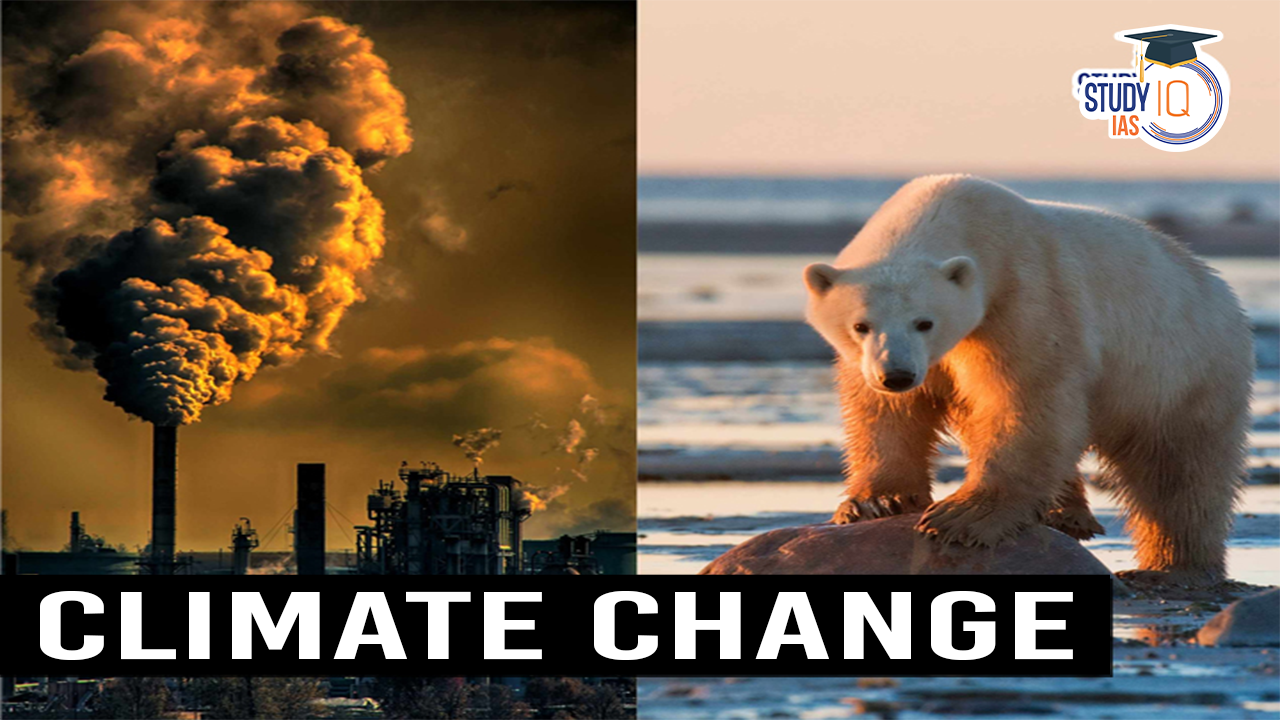Table of Contents
Context: January 2025 was officially the hottest January ever recorded globally, according to new data released this week by the National Oceanic and Atmospheric Administration (NOAA).
What is Meant by Climate Change?
- Climate Change refers to long-term shifts in global or regional climate patterns, primarily caused by natural processes and human activities.
- It is characterized by rising global temperatures, changing weather patterns, and increased frequency of extreme weather events.
Causes of Climate Change
Natural Causes
- Volcanic Eruptions: Large eruptions release dust and gases like sulfur dioxide, temporarily cooling the Earth by blocking sunlight.
- Solar Variability: Changes in solar radiation influence the Earth’s climate cycles over centuries.
- Ocean Currents: Phenomena like El Niño and La Niña affect global temperature and weather patterns.
- Earth’s Orbital Changes (Milankovitch Cycles): Variations in Earth’s orbit and tilt impact long-term climate changes.
- Natural Greenhouse Effect: Water vapour and naturally occurring CO₂ help maintain Earth’s temperature but can fluctuate over time.
Human-Induced Causes
- Burning Fossil Fuels: Coal, oil, and gas release CO₂, intensifying the greenhouse effect.
- Deforestation: Cutting down forests reduces CO₂ absorption, increasing its concentration in the atmosphere.
- Industrial and Agricultural Activities: Factories emit carbon, while livestock farming produces methane (CH₄).
- Urbanization and Land Use Changes: Expanding cities reduce vegetation and contribute to heat island effects.
- Pollution and Waste: Landfills release methane, and plastic pollution disrupts ecosystems.
Effects of Climate Change
Global Effects
- Rising Global Temperatures: The increase in greenhouse gas concentrations has led to a significant rise in global surface temperatures.
- Eg., 2024 is confirmed by the Copernicus Climate Change Service (C3S) to be the warmest year on record globally, and the first calendar year that the average global temperature exceeded 1.5°C above its pre-industrial level.
- Agriculture: Climate change affects water availability for irrigation and increases pest attacks, impacting crop growth and productivity.
- Eg., A 2°C rise in global mean temperatures by 2100 could significantly disrupt current farming systems.
- Extreme Weather Events: There’s an increased frequency of extreme weather events, such as droughts and floods, due to changing rainfall patterns.
- Livestock Production: Climate change leads to productivity losses in livestock due to temperature increases and alters the availability, quality, and prices of inputs like fodder, disease management, and water.
- Water Resources: Rising water temperatures intensify pollution and negatively affect aquatic habitats. Increased evapotranspiration leads to the shrinking of some water bodies.
- Sea-Level Rise: Climate change is raising sea levels, threatening vital infrastructure, salinating freshwater resources, and damaging agriculture due to increased soil salinity.
- Eg., Global average sea levels have risen approximately 8:9 inches (21–24 centimetres) since 1880, with the rate of increase accelerating in recent decades.
- Ecosystems and Biodiversity: Changes in climate can lead to the extinction of some species and increased acidification of water resources.
- Human Health: Climate change threatens human health by increasing incidences of heatstrokes and vector-borne diseases.
- Eg., The World Health Organization estimates that between 2030 and 2050, climate change may cause approximately 250,000 additional deaths per year from malnutrition, malaria, diarrhoea, and heat stress.
Effects on India
- Extreme Weather Events: Increased frequency of heatwaves, floods, droughts, and cyclones.
- Eg., The 2023 monsoon floods in Himachal Pradesh caused significant casualties and infrastructural damage.
- Rising Temperatures and Heatwaves: More frequent, prolonged, and severe heatwaves.
- Eg., Delhi recorded 52.9°C in 2024, its highest-ever temperature.
- Agricultural Disruptions: Unpredictable monsoons, desertification, and soil erosion impact crop yields.
- Eg., Punjab’s wheat yields declined due to heat stress in 2023.
- Water Scarcity: 54% of India faces high-to-extreme water stress (World Resources Institute).
- Eg.,: Shrinking Himalayan glaciers threaten river water supply.
- Sea-Level Rise & Coastal Erosion: Threat to coastal cities like Mumbai, Chennai, and Kolkata.
- Eg., Sundarbans losing landmass, impacting local communities.
- Health Hazards: Increased cases of vector-borne diseases (malaria, dengue).
International Efforts to Combat Climate Change
Key International Organisations
- UN Framework Convention on Climate Change (UNFCCC): Serves as a platform for global negotiations on climate action.
- Intergovernmental Panel on Climate Change (IPCC): Provides scientific insights and assessments to guide climate policies.
Major International Agreements
- Paris Agreement (2015): Aims to restrict global temperature rise to well below 2°C above pre-industrial levels.
- Kyoto Protocol (1997): Established legally binding emission reduction commitments for developed nations.
Global Climate Programs
- REDD & REDD+ : Market-based mechanisms designed to curb greenhouse gas emissions from deforestation and forest degradation.
- Clean Development Mechanism (CDM): Enables developed nations to invest in emission reduction projects within developing countries under the Kyoto Protocol.
- Sustainable Development Goals (SDGs): Particularly SDG-13, which focuses on climate action and resilience.
Other International Initiatives
- Technological Innovations: Advancements in renewable energy, Carbon Capture and Storage (CCS), and green infrastructure are being prioritized.
- Public Awareness Campaigns: Global initiatives like Earth Hour promote climate consciousness and encourage community participation.
Indian Government Initiatives to Tackle Climate Change
Policy and Action Plans
- National Action Plan on Climate Change (NAPCC): Eight missions, including the National Solar Mission, National Water Mission, and Green India Mission.
- State Action Plans on Climate Change (SAPCCs): Tailored climate adaptation and mitigation strategies at the state level.
Heatwave Management & Disaster Preparedness
- Heat Action Plans (HAPs): Over 250+ HAPs developed for urban and rural areas.
- Focus on early warning systems, modified working hours, and cooling shelters.
- National Framework for Heatwave Mitigation and Management (2024): A long-term strategy for preparedness and mitigation.
- Common Alerting Protocol (CAP): Improved heatwave alerts and early warnings.
Water Management Initiatives
- Jal Jeevan Mission: Ensures piped drinking water for all rural households.
- Atal Mission for Rejuvenation and Urban Transformation (AMRUT): Focuses on urban water conservation.
- Catch the Rain Campaign: Encourages rooftop rainwater harvesting.
Renewable Energy & Emission Reduction
- National Solar Mission: Targets 500 GW of non-fossil fuel capacity by 2030.
- Faster Adoption & Manufacturing of Electric Vehicles (FAME): Promotes EVs for reducing carbon emissions.
- Perform, Achieve, and Trade (PAT) Scheme: Encourages industries to reduce energy consumption.
Ecosystem & Biodiversity Conservation
- National Adaptation Fund for Climate Change (NAFCC): Supports projects in agriculture, forestry, and water resources.
- Afforestation Projects (Green India Mission, CAMPA): Focus on increasing forest cover and carbon sequestration.


 Salkhan Fossil Park Joins UNESCO’s Ten...
Salkhan Fossil Park Joins UNESCO’s Ten...
 Forest Conservation Act 1980, Objectives...
Forest Conservation Act 1980, Objectives...
 Rinderpest: Causes, Transmission, Sympto...
Rinderpest: Causes, Transmission, Sympto...





















